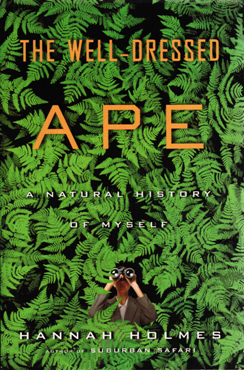
The Well-Dressed Ape: A Natural History of Myself
by Hannah Holmes
It turns out that a lot of human behavior and biology is revealed in one of our most common acts: driving a car.
As Hannah Holmes shows in her humorous study of our kind – treating us as any other animal and finding our many animal counterparts – driving explains a lot. An automobile is just a tool; we beat the rest of animalkind in number and complexity of tools. Our ability to operate cars comes from our evolution into bipeds with dexterous hands and opposable thumbs, topped with big brains. We use cars because our legs, though admirably evolved to run steadily and for long distances, can only get us so far in our hunts (er, commutes). The make and model of our cars telegraph our status; like chickadees, whose females will drop their males for a better one without a thought, we are a status-obsessed species. And finally, the way we drive is restricted by several complex rules designed to protect us from the piles of car accidents that would occur otherwise.
Holmes covers ground far beyond one human behavior. Traveling across continents, up mountains and into deserts, to study a variety of cultures as well as our own, Holmes explains the evolution of and contextualizes in the animal world our mating habits, our abundant language, our vast diet, and, among many other things, our ability to live in harsh climes (which over many, many generations can produce what she calls the “cold-engineered face,” with its small nose and soft brow).
She starts with a funny bit of self-scrutiny in the mirror, to help explain why humans are so tall, oddly-shaped, and hairless, why our knees are so funny and why our mouths carry such harmless canines. She takes on, too, why we carry fat beneath our skin rather than, say, in a hump like the camel, and why the females of our species have breasts even when they aren’t nursing. On that point, evolutionary theories, of which Holmes offers an admirable number throughout the book, suggest alternately that they evolved to signal fertility, or that they evolved to look like butts, so as to attract mates from the front and the back.
The specifics of the sexes is one of Holmes’ particular interests – as she discusses each human trait, she notes where men differ from women, and the differences are many (she does, however, rebuke economist Larry Summers for generalizing about female scientific achievement). Female brains are smaller in size (though as Holmes writes, “size isn’t everything”). Female brains have more white matter and less gray matter. Women register noise more quickly thanks to estrogen and a smaller head. Men emit the only clearly identified human pheromone. Male hearts beat faster in response to pain, and male brains are flooded with stress and pain-killing chemicals, unlike female brains (perhaps, Holmes writes, because women “avoid harm ‘for two.'”
The Well-Dressed Ape also notes some of the oddities of human behavior. We become overweight because we eat far more than we need, though other animals tend to put on weight for a purpose, like migrating birds or hibernating woodchucks. We opt not to have children, as Holmes, who calls herself the “dead-end twig of our [family] tree,” did. We use mind-altering drugs (though cats do favor a pinch of catnip, Holmes notes). We lie and are capable of thinking in the abstract, presumably because of our big brains and their capacity to manage our countless social ties. We “rearranged the earth” to an exponentially greater degree than the dam-building beaver, poisoned it with our activities, and even changed the Earth’s temperature.
Most unique, perhaps, is humankind’s recent drive to act against our biological impulses to protect animals that once preyed on us, and to refrain from altering the Earth as much as we could. “Foxes, given bulldozers for digging out bunnies, would make a stunning mess,” Holmes writes. That is, our uniquely human quality could yield a closer relationship with animals than our natural biological tendencies – a puzzling notion that shows how difficult it is to answer the question Holmes asks: what does it mean to be human, and what does it mean to be an animal?
Excerpt: “Just this morning, I issued the gentlest of growls over his letting hot water – and our shared resources – run down the drain. Just this morning he held eye contact a second longer than usual when I announced my intention to trade resources for a pedicure. The war’s never over. Underlying our civil little war is probably a more primal disagreement. We have agreed to form a pair, but deep down, in our dark, instinctual guts, we both know we would each improve our legacies if we had offspring with a raft of different mates. It doesn’t matter that we’re both beyond that stage of our lives. Like a fat cat’s urge to catch a bird it can’t eat, such instincts aren’t the sort of thing you can turn off. More problematic, the male and female instincts result in a grand mismatch of agendas.”
Further Reading: Suburban Safari: A Year on the Lawn and The 10,000 Year Explosion: How Civilization Accelerated Human Evolution




Send A Letter To the Editors